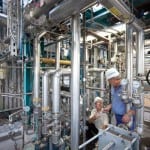The $8 million pilot project funded by 37 power companies from around the world to test Alstom’s advanced chilled ammonia process on a 1.7-MW flue slipstream at We Energies’ coal-fired Pleasant Prairie power plant in Wisconsin has demonstrated more than 90% carbon capture—or about 40 tons each day—sponsors said on Thursday.
Results from the project, which began in the spring of 2008 and will conclude later this year, “predicted performance” of the chilled ammonia carbon capture system at an operating plant, Alstom, We Energies, and the Electric Power Research Institute (EPRI) told reporters at a press conference.
It had achieved key research metrics around hours of operation, ammonia release, CO2 removal levels, and CO2 purity. In doing so, the project demonstrated “the fundamental viability of the carbon capture technology in real-world conditions such as changes in temperature and humidity, the inevitable starts and stops of a large power plant, and the environmental hurdles that go along with using any chemical process,” the companies said.
What the Results Show
The Pleasant Prairie plant, a field pilot designed to validate the “proof of concept,” was the first opportunity to test different unit operations as a fully integrated process in a continuous mode, capturing CO2 from actual flue gas, the companies said. After several months resolving various issues that arose during initial operations, in September 2008, the project began operating 24 hours per day, 7 days per week, with only two outages for the pilot plant’s maintenance.
Over time, the pilot plant’s performance improved steadily to the point that stable absorber operation at 100% of design flue gas flow was established in April 2009, the companies said. It also proved the process concept: As well as demonstrating the removal of 90% of CO2 at design conditions, it consistently showed a pure CO2 stream with ammonia release of less than 10 parts per million (ppm) and water content of less than 2,500 ppm. Other impurities—which the companies did not specify—required further testing and evaluation, they said.
What’s Next
“This project has been a success. It proved what we needed to know to stay on schedule to commercialize carbon capture technology for new and existing power plants by 2015, a necessary step to meet ambitious climate change targets being proposed by policy makers in the U.S. and around the world,” Alstom U.S. President Pierre Gauthier said.
Gauthier said that the next step will entail a scale-up demonstration at two product validation facilities. The first—a 20-MW capture system at the 1,300-MW American Electric Power (AEP) Mountaineer Plant in New Haven, W. Va.—is scheduled for commissioning at the end of this month. It is expected to remove an estimated 90% of CO2 from the flue gas stream it processes, capturing more than 330 tons of CO2 per day—or more than 110,000 tons per year.
The captured CO2 from that plant will then be compressed, pipelined, and injected into two different saline reservoirs located approximately 8,000 feet beneath the plant site. Battelle Memorial Institute will serve as the consultant for AEP on geological storage, as an extensive monitoring system will be used to track the extent of the sequestered CO2 over time.
The site of a commercial demonstration project is still being determined, Alstom said on Thursday. The company said, however, that when that project—at the final demonstration stage—is commissioned, it is expected to capture 1 million to 1.5 million tons of carbon dioxide per year and use it for enhanced oil recovery or store it in an underground formation.
Alstom, meanwhile, is pursuing 10 demonstration projects in six different countries, including the We Energies project and the partnership at Mountaineer with AEP. The Mountaineer project is one of two current or planned post-combustion carbon capture and storage (CCS) demonstrations for which EPRI has formed an industry collaborative to support the management of testing and evaluations.
The EPRI collaborative will support the integration process/design of CO2 capture technologies and the monitoring and verification of CO2 storage, and it will assess the large-scale impacts of CO2 controls and storage on post-combustion coal-fueled generation. The data collected and analyzed by the collaborative will support efforts to advance CCS technologies to commercial scale and provide information to the public and industry on future electricity generation options.
On the Cost Factor
Sponsors on Thursday downplayed the cost per captured ton of CO2 , saying that the purpose of the project wasn’t to conduct a cost analysis. It would become more relevant as they sought to scale up the technology, the companies said, however.
Even so, Gauthier added that the company was confident that when chilled ammonia technology was scaled up and operating on full-size power plants, it could produce power at cost that would be comparable to—and perhaps less than—power generated by renewable sources. At the same time, the Alstom head said he could not discuss what his company had spent on the Mountaineer project. AEP has been reported as having invested more than $70 million in the Mountaineer project.
“It’s an important factor, but we don’t see this as an issue. Renewable power is more expensive,” he said. “The idea here is to develop the technology and make it commercially acceptable, and at this point we are very encouraged by the results that we have.”
Sources: Alstom, We Energies, EPRI








